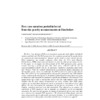Rajner M. i A. Brzeziński. „Free Core Nutation period inferred from the gravity measurements at Józefosław”. Studia Geophysica et Geodaetica 61 (4): 639–56.
- [bib]
@article{Rajner17fcn,
}title = {Free Core Nutation period inferred from the gravity measurements at Józefosław}, author = {Rajner, Marcin and Brzeziński, Aleksander}, journal = {Studia Geophysica et Geodaetica}, year = {2017}, publisher = {Institute of Geophysics, The Czech Academy of Sciences}, address = {Boční II/1401, 141 31 Praga 4, Czechy}, doi = {10.1007/s11200-016-0174-4}, volume = {61}, issue = {4}, month = {oct}, pages = {639-656}, issn = {0039-3169}, - [streszczenie]
The Free Core Nutation (fcn) is an important eigenmode which affects both Earth rotation and body tide. The fcn parameters, the resonance period and the quality factor are important for understanding the dynamics of the Earth at nearly diurnal periods. Those parameters are usually estimated either from the Very Long Baseline Interferometry (vlbi) observations of nutation, or from the tidal gravity measurements. In this paper we investigate the determination of the fcn parameters from gravity records covering a period of more than three years, collected with the use of a LaCoste&Romberg Earth Tide no. 26 gravimeter, located at Józefosław observatory near Warsaw. From the resonant enhancements of gravimetric factors and phases of diurnal tidal gravity waves, we could infer the fcn period to be equal to 430 sidereal days. This result is in very good agreement with previous gravimetric and vlbi nutation results, confirming the discrepancy in the dynamic flattening of the outer liquid core from its theoretical value based on the hydrostatic equilibrium assumption. The estimated fcn quality factor (Q ≈ 1300) is considerably smaller than the vlbi nutation result, which confirms that the local gravity measurements are more sensitive than vlbi global analyses to site-dependent phenomena (such as atmospheric and indirect ocean tidal effects). We also investigated the importance of gravimetric corrections in the fcn analysis, including numerical tests and simulations. This allowed us to estimate the uncertainty of fcn parameters due to improper or incomplete set of environmental corrections. We took also into account the impact of gravimetric factor errors and tidal wave selection on estimated fcn parameters. We demonstrated that despite relatively noisy measurements due to unfavorable gravimeter location, we were able to obtain very good results in case when proper correction and tidal wave selection were applied.
- [doi]
